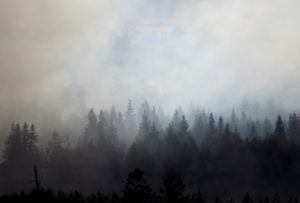ASHEVILLE, NC – June 7, 2023 – Our health can be affected by the quality of the air that we breathe. Clean air is something that most of us take for granted. However, last month, wildfire smoke from western Canada travelled all the way to western North Carolina resulting in hazy mountains and air quality warnings about harmful pollutants. Two weeks ago, I reported that the smoke can lead to health problems. Now there are over 100 newer forest fires in eastern Canada that have added to the problems particularly in the Northeast U.S. The air pollution has worsened here in western North Carolina and in the middle of our state. Good news, the air is improving this week.
Global warming from fossil fuel combustion has led to more extreme weather events like drought and thunderstorms leading to more wildfires and smoke. Wildfires produce greenhouse gases (which contribute to warming of the earth and climate change) and other air pollutants. The greenhouse gases include carbon dioxide and methane. The other air pollutants include nitrogen oxides, carbon monoxide, and large amounts of fine particulate matter (PM). PM2.5 consists of microscopic pieces of solid or liquid droplets, 2.5 microns or less in diameter. If the smoke sinks to ground-level then a build-up of ozone can develop from the chemical reaction of some of the pollutants in the presence of sunlight.
Studies have shown that breathing air pollutants can lead to health problems. PM2.5 particles can cause premature death and heart and lung disease. The particles are small enough to travel in the smallest passageways in the lungs. Their presence can activate the immune system resulting in inflammation in the lungs, with long-lasting effects. Some of them enter the bloodstream and can affect the heart, by constricting blood vessels leading to a higher risk of heart attacks. Ground-level ozone can aggravate lung disease and cause breathing problems.
There are 6 levels of air quality that make up the air quality index from a scale of 0 to 500. Above 101 is ‘unhealthy.’ Above 300 is considered ‘hazardous.’ Last month, western North Carolina was at a yellow level (numerical value 51 to 100) . A yellow air quality level is acceptable, but some at-risk people might be extremely sensitive to the pollutants. Last week, eastern and western North Carolina was at an orange level. An orange air quality level (101-150) means that the air quality is ‘unhealthy’ for at-risk groups, like children, seniors, pregnant women, and those with heart and lung issues. Last week, central North Carolina was at a red air quality level. A red air quality level (151-200) means that everyone may be affected by the ‘unhealthy’ air with at-risk groups at a greater risk of developing a serious health problem. Healthy people can experience coughing, scratchy throat, irritated sinuses, runny nose, headaches, trouble breathing, and shortness of breath if they breath in wildfire smoke. On June 7th, the air quality in New York City was between 348 and 405. Their daylight skies had an eerie orange-red glow with poor visibility. PM2.5 was the primary pollutant.
The fire season in western Canada has been more intense than usual because of climate change. More periods of drought, a greater frequency of lightning strikes, and a recent heat wave caused more than 400 active wildfires. Last month, the western Canadian wildfires sent polluted air over eastern Canada and the United States, from Maine to North Carolina. Last week, the smoke shifted to the Rocky Mountains and the Midwest. The Northeast was most affected and there was impaired air quality in the Midwest and Southern Atlantic states including North Carolina. Over 100 million people have recently been affected by ‘unhealthy’ air quality. Last week, air quality alerts have been issued in 16 states from Vermont to South Carolina. The air quality was so poor in New York City and Philadelphia that commercial airplane flights, major league baseball games, and Broadway shows were cancelled. New York City had more than the usual number of asthma-related visits to their hospitals’ emergency room, according to city Health Department spokesperson Pedro Frisneda.
The sooner the wildfires are extinguished, the sooner this public health crisis will end. While Canada is trying to put out the wildfires, other countries have sent their firefighters to help. The U.S. has sent more than 600 firefighters and equipment. The effects of the wildfires are affected by the weather patterns like low-pressure systems, wind patterns, and by the presence of clouds.
Vulnerable persons should consider checking the air quality index report every day at AirNow.gov . In the event of impaired air quality levels, susceptible individuals should consider wearing a face mask (an N-95 respirator mask is recommended), limiting outdoor activities and time spent outdoors, or staying inside. Keeping the windows closed at home and having air purifiers and efficient air filters will help reduce indoor particle pollution. Don’t forget to limit your pets’ time being outside because they can be affected too.
If the incidence of wildfires continues to increase because of a changing climate, then more and more people are going to be exposed to polluted air. We need to be concerned about the short-term effects of breathing polluted air as well as the long-term health problems. Without our intervention, our children and our children’s children may be forced to deal with this dire situation.
Listen to the full report below:
Contact: Dr. Dick Needleman, Health reporter, 103.3 AshevilleFM, [email protected]
More Posts for Show: Asheville FM News Hour
